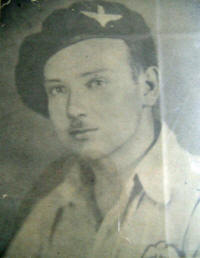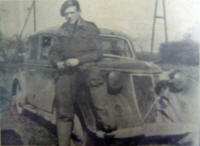[Home] [Events] [Links] [Guestbook] [Contact Us]
89 (Parachute) Field Security Section
317 (Airborne) Field Security Section
Sgt. Lewis Stagnetto, 317 FSS, Intelligence Corps
In 1942, Lewis Stagnetto volunteered for the Armed Forces, aged 18, at Glasgow. At the time he had been studying medicine. As a Gibraltarian, his enlistment was complicated by his “colonial” status. Initially inducted into the General Service Corps, he soon joined the Highland Light Infantry at their Barracks at Maryhill. Whilst under basic training, a requirement for linguists was announced. His fluency in Spanish and near fluency in French rendered him suitable for intelligence duties, after a selection process in London.
Now in the Intelligence Corps, Corporal Stagnetto went for additional training, initially to the Corps Depot at Wentworth Woodhouse, near Rotherham (in Yorkshire) in mid-1943, and then on to the School of Military Intelligence at the Matlock Hydro.
It was at this point that Corporal Stagnetto first met with the with the Corps requirement to provide parachute qualified personnel for Field Security Sections for both 1st and 6th Airborne Divisions. He volunteered.
After the parachute “toughening up” course at Hardwick Hall (in Derbyshire) – the then home of British Airborne Forces, and parachute training at Ringway (Manchester), he was member of the British Army’s famous “Red Berets”. From April/May 1944, it would appear, that before joining 6th Airborne’s 317 (Airborne) Field Security Section (FSS), he was involved in special operations in France.
Stagnetto was sent from 1025 FSRD (Field Security Reserve Detachment) at Highgate, London, to Normandy on 14th June 1944. His tasking concerned him with the organisation of Maquis elements into a cohesive fighting force, followed by, protection of personnel (possibly SOE operatives) who were in the Cherbourg area and, were threatened by both German, Allied and Free French action. This involved operations in the front of (US?) forces, and the prevention of summary execution of Allied operatives who had appeared to act as “collaborators” while passing information to London.
On return to London, after the Normandy Campaign, he was promoted to Sgt and posted to 317 FSS (who also had returned to the UK in August 1944, after Op OVERLORD). FSS tasking involved, arrest and interrogation of enemy intelligence and counter-intelligence personnel, liaison with local resistance and intelligence operators, and other security duties. It is likely that Sgt Stagnetto had been trained in these duties before his missions in France.
After rest and recuperation, the 6th Airborne Division were put on alert for a number of missions including support to Op MARKET GARDEN. Their next mission, however, did not involve parachuting! The German offensive in the Ardennes, otherwise known as the Battle of the Bulge, resulted in the Division alerted on Christmas Eve, deployed in snowy Belgium a few days later to reinforce the US troops.
The 6th Airborne Division were Headquartered at Cierngon and, whilst passing through Jmelle, near Rochefort en route to the HQ for a briefing, Sgt Stagnetto noticed that the helmets of the troops ijn the town appeared a different shape – finally it dawned on him that Jmelle was still in the hands of the Germans. Already posted “Missing in Action” He was able to inform the HQ Intelligence staffs of this on arrival!
As part of the German operation involved the deployment of special troops in US uniform, Intelligence Corps personnel were required to be especially alert. Sgt Stagnetto’s recollection was that it became necessary to “shoot first and ask questions later” due to the large numbers of these “fake Americans” from the Skorzeny Brigade within the operating area.
The Division was moved to the Dutch border area, where liaison was required with the local resistance movements. Large areas of Holland still remained under German control, and Dutch resistance of all political persuasions were active, some fighting each other. 317 FSS were tasked to liaise with the “OD” organisation, but were moved before any real mutual benefit could be achieved. Liaison with resistance groups was something that Sgt Stagnetto had experience of from France.
The 6th Airborne Division returned to the UK in February 1944, and found themselves with only 6 weeks to prepare for their next operation – the largest single airborne operation of WW2, Op VARSITY. 317 FSS conducted security duties within the Divisional area until 24 March 1945, when the Division along with 17 (US) Airborne Division were dropped across the Rhine in Germany proper. 317 FSS were penny packet-ed amongst the airborne brigades, but all of their landing zones surrounded the German town of Hammilkeln.
The VARSITY landing and dropping zones (LZ & DZ) were shrouded in an engineer provided synthetic fog which made it difficult for the pilots to determine the LZ & DZ. It had been determined that from lessons learnt from Normandy and Arnhem that the Division were to be delivered in a single lift, rather than a staged 2 or 3 lift cycle. Sgt Stagnetto was in a glider-borne element of the Division that day.
The Division landed in daylight and at 10:30 am. The Germans were prepared.
Large casualties were experienced in both the parachute and glider forces, however, the main elements of the Division achieved their objectives within 2 hours, air-landed artillery in action within 10 minutes, and the Division was relieved within 8 hours (by 15 (Scottish) Div. Substantial numbers of gliders were destroyed on the run-in by German flak and, some on the LZ by mortar and artillery. Gliders do not always land where they are supposed to.
Sgt Stagnetto was in one of these “strays”. Landing approximately 30km from the correct landing zone, the Horsa glider landed adjacent to a farmhouse. The glider contained over 40 (from Sgt Stagnetto’s account) troops who, realising their predicament immediately took over the farmhouse and prepared defensive positions. German forces in the area became aware of the airborne troops, and fiercely attacked the farm on a number of occasions using armoured vehicles and mortars. Although heavy casualties were sustained – only 7 were left unwounded, when the farm was relieved 2 days later by Canadian forces. German prisoners, at Sgt Stagnetto’s instigation, were stripped of their trousers and boots to stop them escaping and causing more trouble.
317 FSS then regrouped, and, those un-wounded commenced the 6 week march to the Baltic. “One mad, quick, advance”, saw the Division at the forefront of British forces. On the way to the Baltic, 317 FSS and Sgt Stagnetto (who may have been one of the first to enter), discovered the Concentration Camp at Bergen-Belsen. Sgt Stagnetto, using the FSS camera, took some of the first pictures of the site, depicting the worst of Nazi atrocities, for Divisional HQ.
During the advance to the Baltic, Sgt Stagnetto was approached by a senior German officer and his staff, who asked him to receive the surrender of 5000 German troops. His response was to direct the German officer down the road, from which the British troops were advancing, and tell him to keep walking until he met some who could help. 317 FSS were too busy advancing to help.
At Wismar, on the Baltic coast, the Division complete with 317 FSS, met with Russian forces (who Sgt Stagnetto distrusted) and within a few days German ceasefire was complete, with FM Montgomery taking the surrender at Luneberg. Shortly after VE Day, the Division was withdrawn to the UK. There was some concern that, with 1st Airborne Division in Norway on liberation duties, 6th Airborne would be sent to Asia for a drop too far on Japan. VJ day saw the end of that speculation, but elements of the Division were sent to Sumatra/Indonesia for liberation duties and in late 1945, an amalgamated Airborne Division including 317 FSS were sent to Palestine for peacekeeping operations.
Sgt Stagnetto did not accompany the Division to Palestine. On compassionate leave (due to his mother being very ill), his next posting was to a small non-airborne element – 36 FSS. Their duties included the recovery and interrogation of anti-British Maltese who had joined an Italian-sponsored “Free Malta Brigade”, and saw Sgt Stagnetto regularly (and happily) shuttling between Naples in southern Italy and Malta.
His next posting, as a senior NCO, with operational experience, was to the Middle-East School of Military Intelligence, at Almaza, Cairo. His 5 months as instructor at the School lead him to consider the military as a regular career, but his “colonial” status - with over 3 years active service, allowed him “immediate release”.
His application was approved. On return to Gibraltar – having not been home since 1941, he joined the family firm, Gibraltar’s largest importer of wines & spirits and tobacco products.
The formation of the Gibraltar Reserve Regiment saw his commissioning and taking a Company, further continuing his military career. His office in the family firm bore witness to his service (his personal memoirs were lost in a robbery), with a model Dakota aircraft and a captured Nazi Officer’s Dagger (from the Ardennes). He continued to live a full life, becoming Chairman of the Chamber of Commerce and being active in the community. His early death, in 1976, robbed Gibraltar of one of its most prominent figures.
Lewis Stagnetto, pre-Intelligence Corps
Sgt Stagnetto, Op VARSITY




